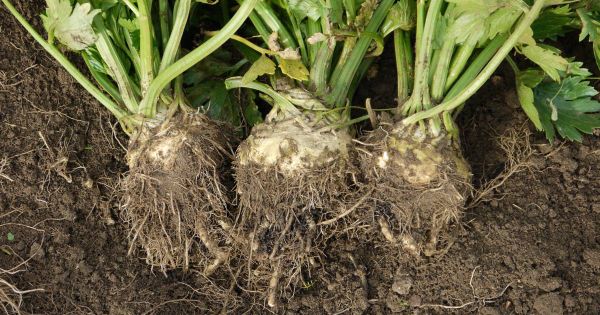Celeriac


Introduction
Celeriac is excellent roasted as an alternative to potatoes, and makes a delicious contribution to soups and sauces with its celery like flavour.
Celeriac is much easier to grow than celery, and aside from flavour, looks very similar to celery with its stems and leaves. However, it is not the stems but the round bulbous crown of celeriac that is eaten, which swells at ground level as the plant matures (similar to beetroot).
Planting
- Planting depth: surface sow, fine covering
(keep in a warm environment) - Planting spacing: 40 cm between plants, 45 cm between rows
Harvesting
- September to February
- Leave on plot and harvest when needed. Consider earthing up to cover crowns.
(inside)
(outside)
(fresh)
(stored)


 = freeze,
= freeze,  = store
= store
Varieties
Celeriac is one of my favourite vegetables to grow as it stores well and has many uses in the kitchen. There are not many varieties of celeriac to choose from, with success mainly dependent upon growing the crop in fertile and moist soil.
The easy way for a gardener to organise their growing and discover gardening ideas.
Growing
The most difficult part of growing celeriac is the early stage of germination, and growing on the seedlings. Celeriac originates from the mediterranean region, and needs a temperature of around 18 °C to germinate. My solution is to sow the seed in shallow drills in a seed tray in my polytunnel, covered by plastic wrap. A greenhouse in a warm and sunny position, or a windowsill, are good alternatives.
If the seedlings dry out, or experience the shock of cold temperatures in late spring, this may lead them to bolt. Like courgettes and squash, they need protection from cold weather until all risk of frost has passed.
Celeriac is relatively slow growing, and following germination, the seedlings are planted into their final growing position and spaced about 12 inches or 30 centimetres apart. It is best to plant them out as soon as it is safe to do so. The longer the growing season, the more time the crowns have to swell to a large size. The crowns should be level with the surface of the soil and not buried.
The plants may need covering with a net to stop birds nibbling the leaves, and they should be watered regularly. When the crowns (actually a swollen part of the stem) start to mature, it is suggested to remove the sideways growing leaves to focus the plants energy on the crown. Leaves growing directly upwards should be left on the plant.
Celeriac has relative few pests, but can be eaten by slugs and snails.
By late August or early September the crowns should be large enough to eat. Celeriac stands well on an allotment or vegetable patch, and can be left in place through winter and harvested when required.
